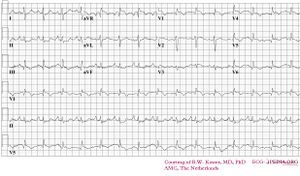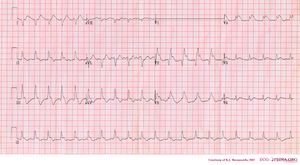Pulmonary Embolism: Difference between revisions
Jump to navigation
Jump to search
mNo edit summary |
No edit summary |
||
| Line 2: | Line 2: | ||
[[Image:pulm_embolism_ecg2.jpg|thumb|Another example of an ECG of a patiënt with pulmonary embolism. Note the tachycardia and right axis.]] | [[Image:pulm_embolism_ecg2.jpg|thumb|Another example of an ECG of a patiënt with pulmonary embolism. Note the tachycardia and right axis.]] | ||
In case of a [[w:Pulmonary_embolism|pulmonary embolism]] several clinical features may be present:<cite>Rodger</cite> | In case of a [[w:Pulmonary_embolism|pulmonary embolism]] several clinical features may be present:<cite>Rodger</cite> | ||
* [[ | * [[Sinus Tachycardia]] | ||
* Stress on the right ventricle: | * Stress on the right ventricle: | ||
**[[Chamber_Hypertrophy_and_Enlargment#Right_atrial_enlargement|right atrial dilatation]] | **[[Chamber_Hypertrophy_and_Enlargment#Right_atrial_enlargement|right atrial dilatation]] | ||
Revision as of 03:22, 17 April 2008
In case of a pulmonary embolism several clinical features may be present:[1]
- Sinus Tachycardia
- Stress on the right ventricle:
- right atrial dilatation
- Heartaxis is to the right
- Right bundle branch block (RBBB)
- Deep S in I
- Q and negative T in III
- T wave inversion anterior [2]
Pulmonary embolism cannot solely be diagnosed using an ECG, but it may be helpful.

